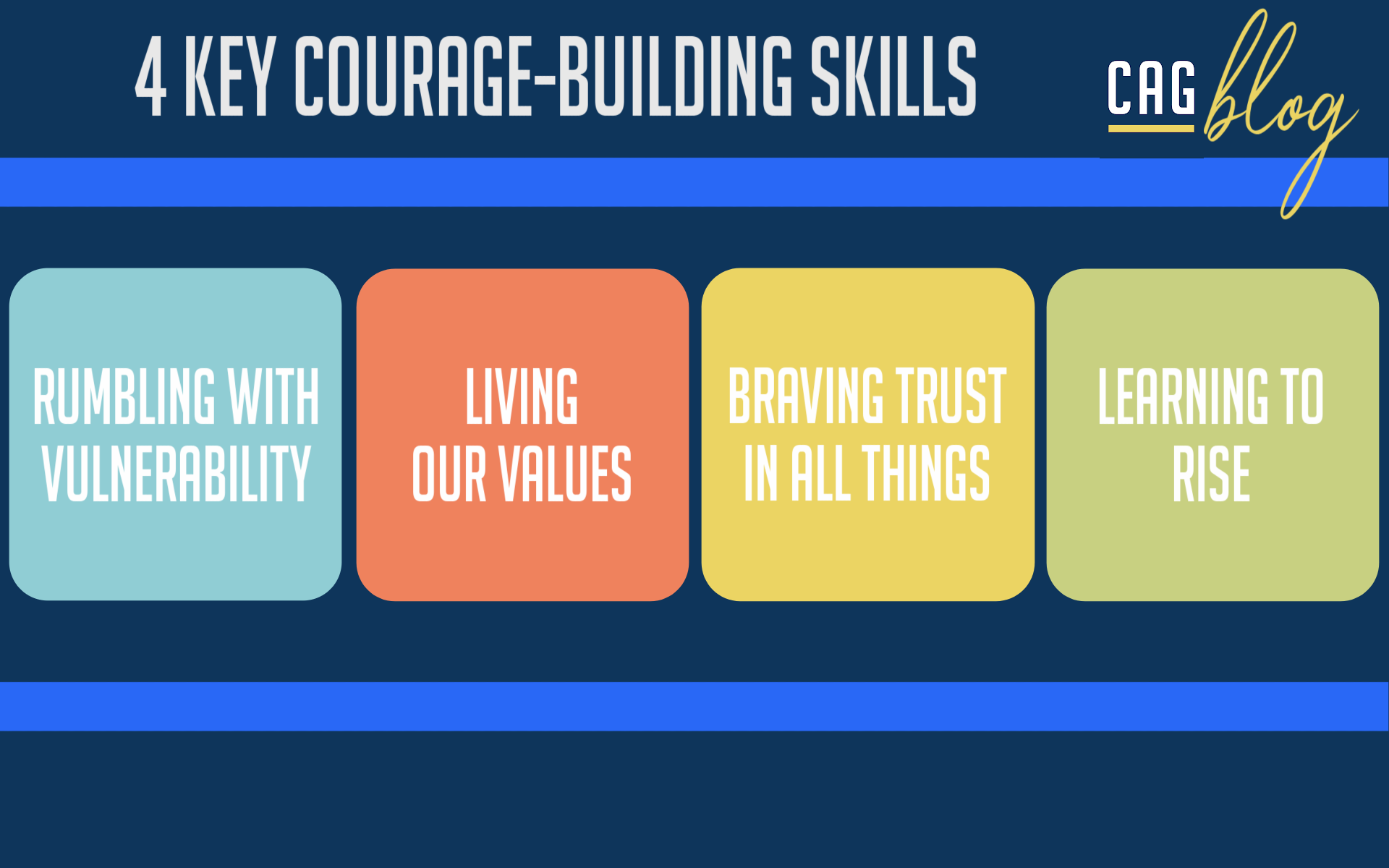
Courage & The Heart of Daring Leadership: Daring Leadership Series Part 2
Courage is the heart of daring leadership. So why is it so difficult to lead in a courageous way? In a word…vulnerability. We’re scared to death of failing ourselves, our teams and telling the truth. And that fear stands in the way of our greatness. So what can we do about it? How can we explore courage and the heart of daring leadership and put it to work for ourselves and our teams, as well as in our own lives? It starts by knowing about the four (4) skills that courage takes to make it happen and cracking those wide open. Did I mention it was scary?!?!
Today’s we’ll identify the four (4) courage-building skills we’re going to need to practice if we want to lead from a place of daring leadership moving forward. It’s Part 2 of our “Daring Leadership Series” where we’re exploring Brené Brown’s Dare to Lead and putting her widely-acclaimed theories into practical scenarios for small business owners, entrepreneurs and non-profit executives.
THE 4 COURAGE-BUILDING SKILLS YOU’LL NEED
First things first. We need to talk about skills. There are four (4) key courage-building skills you’re going to need if you want to start to practice daring leadership and these are:
- Rumbling with Vulnerability (getting used to being uncomfortable in sucky situations)
- Living your Values (sticking to your guns when you know what’s right…even when it’s not easy)
- Braving Trust (learning how to trust yourself and others more freely) and
- Learning to Rise (knowing how to stand back up when we get knocked down)
We’ll spend more time diving into each of these with their own posts later in the series, but for now, we just need to have a clear picture about what we’re working with and where we’re aiming our arrows.

1. RUMBLING WITH VULNERABILITY
When Brown did her research to find out what “courage” means from a leadership perspective, most interviewees couldn’t offer an answer. She writes:
“Just over 80 percent of the leaders, including those who believed that courage is behavioral, couldn’t identify the specific skills; however they could immediately and passionately talk about problematic behaviors and cultural norms that corrode trust and courage.”
In Part 1 of our series, we talked about the ten (10) behaviors that get in the way of the type of leader we want to be. I’m not going to rehash those again, but they are worth understanding to get to the intricacies of courage and vulnerability, because they offer you a bunch of common scenarios you might find yourself in to decide if you’re leading from a place of courageous vulnerability, or fear and shame.
First, it’s quite clear that you can’t get to a place of courage without rumbling with vulnerability. To rumble is to get our hands dirty digging into what’s wrong, what’s holding us back and what’s getting in our way. Frankly, it’s talking about what scares us. It is the sucky bit that we work so hard to avoid by any means possible. “Courage and fear are not mutually exclusive,” she adds.
We’ll talk more about shame, fear and armor later in the series because they’re all related to vulnerability and are hot topics in this camp.
2. LIVING INTO OUR VALUES
The next most important courage-building skill is living our values. This means “creating a culture where people feel safe, seen, heard and respected,” she writes. As leaders, it means never remaining silent about hard things. I have been on several teams where leaders desperately wanted to avoid the hard things. Oftentimes, those leaders were not directly responsible for the hard situations they were being asked to manage, and thus, assumed no discussion meant no problem, or a lesser problem. (Sometimes this even happened when the hard situation was not aligned with the leader’s personal values and baffled the team.)
This avoidance tactic only fostered greater resentments, confusion and assumptions by many team members and didn’t solve anything. When we talk about what’s hard we signify to others that we (a) can see that it is hard, (b) agree that it is hard, and (c) empathize with the members of our team about how it makes everyone feel. It brings humanity to a situation where we desperately need to feel loved, included, seen, and accepted. It is not a sign of weakness, but rather a sign of significant strength to be willing to acknowledge and own this truth.
When we bring our values along with us, and stick to them, we give ourselves more tools to deal with hard situations and help navigate what we’re going to do about them as leaders. Values offer clarity about our courage.

3. BRAVING TRUST
Thirdly, we must be brave enough to trust ourselves and trust the people we are leading. Self-awareness and self-love matter. Who we are is how we lead. In my own leadership, this mostly has come down to understanding when I’m not leading from my best place and true self, and that means changing something to change my behavior. Sometimes that means walking away if I have no power to reestablish trust in the relationship. Knowing your limits can be lonely and scary y’all.
I like the philosophy of mood states as an indicator of leadership health. When we are feeling good about ourselves and our place in the work, we can simply function better. We are more grateful, creative, resourceful, hopeful, patient, curious and flexible. When we’re feeling lousy (and that is most definitely tied to shame and fear) we’re more likely to be impatient, irritable, worried, defensive, judgmental, self-righteous, stressed and angry. (You’ll note how much these behaviors correlate with the ten (10) behaviors that get in the way of the type of leader we want to be and that’s no accident.)
Being honest about trust, and when we’re scared about trusting others is a must. We need to be specific about what scares us and threatens our trust with our team. We need our team to feel they can trust us when they are honest with us in return. We’ll dig into trust more later in the series.
4. LEARNING TO RISE
Finally, we must be practiced at the feelings and shame we endure when we’re forced to confront our own failings and learn how to rise from those experiences. The true underlying obstacle to brave leadership is how we respond to our fear. It’s our armor.
I love this quote from the book that sets the entire tone for learning to rise:
“When we have the courage to walk into our story and own it, we get to write the ending. And when we don’t own our stories of failure, setbacks, and hurt—they own us.”
One of the best things I’ve ever done is risk everything so I can learn how to fail at something nearly every single day and get back up. I openly talk to people regularly about how I’m failing and working on those failures so they do not pack the wallop, sting and pain that often is so closely tied to the fear that someone will realize we’ve failed.
Anyone brave enough to try the most audacious goals will know failure well. And they will still rise the next day and tackle a new problem.
COURAGE: THE HEART OF DARING LEADERSHIP
When we finally are able to own that we’re feeling scared, vulnerable and afraid we might fail, only then will we be able to put our new courage-building skills to work for us and start to control those fears. To trust our gut and lean into our values.
That probably means saying a whole bunch of things out loud that we’d prefer not to say about our feelings and what we’re willing and unwilling to tolerate in our teams. Probably some of my best experiences on teams come down to honesty, trust and leveling the playing field. Sometimes you’re not able to change everything about the team, but you are able to change your relationship with that team and your own vulnerable rumblings. You are able to decide if you’re approaching that team from a healthy state of mind, or an unhealthy one.
The question is…will you have the courage to truly lead the next time you’ve got the opportunity to dare greatly in your own journey?
You’re reading Part 2 in our series. Read “What kind of leader are you?” Part 1 in the Daring Leadership series.
Further Reading
Strategic Planning

Who Should Be Involved in Strategic Planning?
After you’ve learned more about strategic planning and whether you need a strategic plan of your own, you might start...
Marketing Strategy

Creating Your First Marketing Strategy – Free Template
Creating your first marketing strategy involves documenting the steps and ideas necessary to achieve your marketing...
Leadership

What kind of leader are you? Daring Leadership Series Part 1
There have been times in my life where I’ve been really proud of my leadership, and there have been others where I...
Business Tools

Writing Your First Business Plan – Free Template
Writing your first business plan is one part knowledge, and another perseverance. Modern sentiment suggests that as an...
